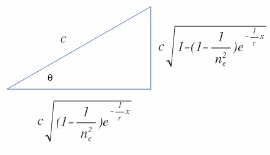We need to know more of photons in free space to use it to understand time speed and time travel.
From the conservation of energy equation,
\({v}^{2}_{t}+{v}^{2}_{s} = {c}^{2}\)
differentiating both sides with respect to time,
\(2{v}_{t}\cfrac{d{v}_{t}}{dt}+2{v}_{s}\cfrac{d{v}_{s}}{dt} = 0\)
\({v}_{t}\cfrac{d{v}_{t}}{dx}\cfrac{dx}{dt}+{v}_{s}\cfrac{d{v}_{s}}{dt} = 0\)
\({v}_{t}\cfrac{d{v}_{t}}{dx}{v}_{s}+{v}_{s}\cfrac{d{v}_{s}}{dt} = 0\)
\({v}_{t}\cfrac{d{v}_{t}}{dx} = - \cfrac{d{v}_{s}}{dt} \)
Now consider time being terminal velocity in space and photon speed also as terminal velocity in space, both will then have an inverse proportional relationship with space density. For a photon,
\({v}^{2}_{t}+{v}^{2}_{s} = A-B{d}_{s}(x)\)
Differentiating with respect to \(x\)
\(2{v}_{t}\cfrac{d{v}_{t}}{dx}+2{v}_{s}\cfrac{d{v}_{s}}{dx} = -B\cfrac{d{d}_{s}(x)}{dx}\)
Since, \({v}_{t}\cfrac{d{v}_{t}}{dx} = - \cfrac{d{v}_{s}}{dt} \)
\({v}_{s}\cfrac{d{v}_{s}}{dx}-\cfrac{d{v}_{s}}{dt}=-\cfrac{B}{2}\cfrac{d{d}_{s}(x)}{dx}\)
If we let \(\cfrac{d{v}_{s}}{dt} = 0\) since there is no time dependentce on the R.H.S, that is, to optimize in time; ie. for an extrema of \({v}_{s}\) in time,
\({v}_{s}\cfrac{d{v}_{s}}{dx} =-\cfrac{B}{2}\cfrac{d{d}_{s}(x)}{dx}\)
for the case of \({d}_{s}(x)\) = constant, ie a uniform medium,
\({v}_{s}\cfrac{d{v}_{s}}{dx} = 0\)
\({v}_{s}=C\) or \({v}_{s}=0\) we are looking for non-trivial answers as such
\({v}_{s}=c\)
since we know that in uniform free space photon speed is light speed \(c\). And in general photon speed in any uniform medium is a constant.
Then we consider a photon entering a uniform medium from free space,
\({d}_{s}(x) = \cfrac{{n}_{o}}{B}step(x)\) where the medium is modeled as a step function at \(x\) = 0,
ie, replacing \(B\) with \({n}_{o}\)
\({v}_{s}\cfrac{d{v}_{s}}{dx} =-\cfrac{{n}_{o}}{2}\cfrac{d (step(x))}{dx}\)
\(\cfrac{1}{2}\cfrac{d{v}^{2}_{s}}{dx} = -\cfrac{{n}_{o}}{2}\cfrac{d (step(x))}{dx}\)
Integrating both sides,
\({v}^{2}_{s} = C-{n}_{o}step(x)\)
We know that \({v}_{s}\) = \(c\) when \(x\) = 0
-, so when \(x\) > 0
\({v}^{2}_{s} = c^2-{n}_{o}\) where \(c\) is light speed.
So,
\({v}_{s} = \sqrt{c^2-{n}_{o}}\)
If we consider the ratio in change of speed after the photon has passed into the medium,
\({v}_{s} =c. \sqrt{1-\cfrac{{n}_{o}}{c^2}}\)
\({v}_{s} =c.sin{\theta}\)
where \(\theta = sin^{-1}{ \sqrt{1-\cfrac{{n}_{o}}{c^2}}}\)
Remember that refractive index \(n\),
\(n=\cfrac{c}{{v}_{s}}=\cfrac{1}{sin{\theta}}\) ≥ 1
This is consistent with established definition of \(n\). There is a relationship between optical density and space density. We see that,
\(\theta = sin^{-1}{ \sqrt{1-\cfrac{{n}_{o}}{c^2}}}=sin^{-1}{\cfrac{1}{n}}\)
then,
\( \sqrt{1-\cfrac{{n}_{o}}{c^2}}=\cfrac{1}{n}\)
\(c^2-{n}_{o}=\cfrac{{c}^{2}}{{n}^{2}}\)
\({n}_{o}=c^2-\cfrac{{c}^{2}}{{n}^{2}}=c^2(1-\cfrac{1}{{n}^{2}})=B\)
Consider again,
\({v}^{2}_{t}+{v}^{2}_{s} = A-B{d}_{s}(x)\)
At \(x\) = 0
- \({d}_{s}(x)\) = 0, so \(A\) = \(c^2\). And so at \(x\) = 0
+
\({v}^{2}_{t}+{v}^{2}_{s} = \cfrac{{c}^{2}}{{n}^{2}}\)
where \(\cfrac{c}{n}\) is the speed of photon in a medium of refractive index \(n\). We started with energy conservation equation,
\({v}^{2}_{t}+{v}^{2}_{s} = {c}^{2}\)
on crossing a medium boundary \({n}_{o}step(x)\), we obtained,
\({v}^{2}_{t}+{v}^{2}_{s} = \cfrac{{c}^{2}}{{n}^{2}}\)
Energy is lost, by a factor of \((1-\cfrac{1}{{n}^2})\).
We also see clearly what does least time, (ie. \(\cfrac{d{v}_{s}}{dt} = 0\)), that is, to optimize in time means; all changes in the energy conservation expression occurs in \({v}_{s}\) only, as we set \(\cfrac{d{v}_{s}}{dt} = 0\). This, however may not be true if we are able to track individual photons. Under normal circumstances, we observe the behavior of many photons over time and obtain time averaged parameters. If we are able to focus on the behavior of individual groups of photons it is likely that the change in time and space be distributed according to some distribution function. That in time and space, the photons disperse. From the differential equation, we have the case of \(\frac{d{v}_{s}}{dt} = 0\).
 \(B=\sum^{all-vectors}_i{\cfrac{1}{4\pi \varepsilon_o }.\cfrac{q_i}{a^3_i}}\)
\(B=\sum^{all-vectors}_i{\cfrac{1}{4\pi \varepsilon_o }.\cfrac{q_i}{a^3_i}}\)



























